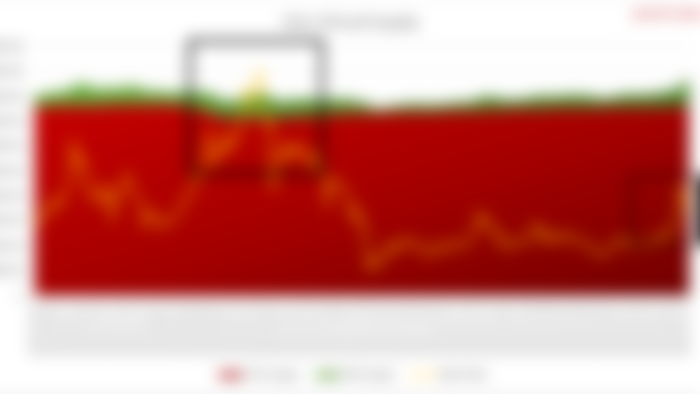After UST crashed - Should HBD Lower Rates Back To 12%?
With the recent crash of UST, stable coins have gotten a lot of bad press and the returns UST provided on Anchor were comparable with HBD. But we know now how it ended with UST and it is a far larger stable algo coin compared to the amount of HBD that we have circulating.
We all know how great HBD is and the awesome 20% (22% compounded) returns, I thought it would be a good idea to look at the risks for HBD and how we could avoid a UST situation. Does that mean we should lower rates back to 12%?
One of the arguments suggested that we needed to raise the rates on HBD is to attract capital to Hive. The eco-system on Hive is Hive, and yes this can fluctuate in value, but that is only against fiat. 1 Hive is still 1 Hive. If we want to attract capital to Hive, it can also be attracted to liquid Hive or Hive Power too and earn good returns. If we attract too many speculators, would the interest become too much like on UST and cause a death spiral?
Currently, there are not too many use-cases for HBD, but the plan is to grow the use-cases for using HBD as a payment system in games and for regular transactions. A fixed amount to the $ will give people some reliability in the value when using HBD instead of say Hive. I think there is some merit to this argument, although with Hive's no transaction fees, surely it makes sense to use Hive for transactions instead?
The whole inflation of Hive and its rewards pool is what keeps things moving on Hive. Is using a stable coin, going back to the world of fiat currencies and their inherent risks?
BitcoinCash and Litecoin are two cryptos used for transactions a lot due to their low costs. But Hive is powered by RC so is free. Both of these do not have a fixed value and therefore are not at risk of causing a death spiral. Should we be promoting Hive more than HBD?
Many games running on hive also use layer 2 tokens quite successfully and therefore, why do we need to use HBD for this? This also leads on to the fact that layer 2 tokens are taking a hammering with the higher rates with HBD and don't pose any threat to the Hive ecosystem. In fact, they are an extra RISK for the holders because they are on the second layer. So earning any extra returns could be more justified than paying extra returns to HBD holders when it poses a risk to Hive.
The value of Hive layer 2 tokens to the Hive Ecosystem cannot be underestimated too. They promote Hive tribes and communities. Should they switch to HBD?
20% is a very large return and should attract more capital to Hive. As we have seen with the collapse of UST, rates of around 20% are VERY high and usually not sustainable or tied with extreme risk.
With the current bear market, returns on other stable coins are greatly reduced. USDT and USDC (the top market cap stable coins) rates are up to 12%, should HBD rates be lower to mirror the dynamic market rates available? 8% seems a big gap?
Risk to the Hive eco-system
It was only back in October that the debt limit was breached as you can see in the graphic below by @arcange. That is only around 7 months ago and we didn't have 20% rates back then.

With the recent move down in price to around $0,50, there was a sharp move up in the debt limit %. This was basically a 200% move up during a week. If the bear market continues, we could reach the debt limit before it is even raised to 30% in the next fork.
The DHF is not included in the current 10% debt limit. Therefore, the real debt limit is much higher than the one calculated here. So the real strain on the ecosystem could be much greater. Are there enough users and use-cases on Hive to support a 20% interest rate?
The current debt limit is low at 10%, therefore this should offer some protection to Hive. But if the limit can be breached so easily, does it make sense to offer high rates to possibly breach it quicker and increase volatility?
The proposed increase to a 30% debt limit would put even more strain on the Hive Eco-system. The Hive Power holders are basically guaranteeing a 20% return to HBD holders. This could cause much higher inflation for liquid hive holders and those powered up and drastically reduce their returns. This could cause a death spiral until the debt ceiling is reached. Therefore I predict we would likely hit the ceiling faster than we expect with the huge downward pressure on Hive.
HBD > Hive Power
Not only could we see lower Hive prices to support a more valuable HBD, but if someone is holding Hive Power, they get just 2,88%, but if they curate or delegate their Hive Power, this can increase. But not to 22%, perhaps 11-12%, yet having Hive Power or holding Hive benefits the Hive eco-system because it promotes engagement, activity, gaming, curating and many other hive use-cases. It is a win/win for all.
Currently, HBD doesn't do any of that but the HBD returns are supported by those who are active on Hive. These imbalanced returns could cause instability within the blockchain. Will we see another build-up and collapse as we saw on Anchor?

Holding HBD on exchanges and the polygon network would cause large amounts of HBD to be short sold that would need to be compensated by Hive holders. Could these speculation risks also cause a death spiral risk? Even more, so that they are held "outside" of the hive ecosystem.
Hive Protection Mechanisms
Hive has more protection mechanisms than Luna and if there are any perceived threats, these would start to kick in. We have the hair cut if the debt limit goes above a certain level.
We also have a rewards system where it can payout in HBD and Hive. If the debt limit is breached, this would force rewards to be paid out only in Hive until it is back at a sustainable level.
If HBD becomes too popular, the Witnesses can also reduce interest rates to make HBD less popular. Although with HBD on exchanges, this could cause it to be dumped very quickly unlike in your Hive wallet.
What are your thoughts?
Does HBD have good protection mechanisms to avoid another Luna collapse? Are they even comparable?
Thanks for reading.
Resources:
Title picture was made by myself using Canva.
Other graphics are credited as above.

